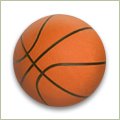In my
last post, I reviewed some of the common reasons that basketball players develop patellofemoral pain syndrome (PFPS), otherwise known as miserable malalignment syndrome.
So what can you do (besides playing less, icing the knee, and taking ibuprofen) to improve this condition? It really depends upon the underlying cause(s) for this condition, but here are the most common non-surgical interventions:
1)
Orthotics (Shoe Inserts) - for players who have flexible
flat feet (foot hyperpronation). While you can buy them off the shelf, you'll get the best fit with custom molded models from your local
orthotist or
physical therapist.
2)
Quadriceps Strength Training - In cases where there is an imbalance of these muscles (located on the front of the thigh),
closed kinetic chain exercises (where the foot is in contact with a surface) to strengthen the quadriceps (with a special focus on the
vastus medialis) can improve symptoms.
3)
Stretching - A tight
iliotibial band can pull the patella off to the side, while tight hamstrings can increase the pressure on the kneecap by pulling it back up against the femur/thighbone. Tight achilles tendons can also worsen foot hyperpronation. Stretching these muscles regularly should be an important part of any intervention to decrease PFPS.
4)
McConnell Taping - This
taping maneuver, usually performed and then taught by a physical therapist or
athletic trainer, can be used to keep improve the alignment of the kneecap during activity. It helps decrease the pain of PFPS, but is NOT a replacement for appropriate rehabilitation and maintenance exercises.
5)
Knee Braces & Sleeves - may help decrease pain in patients who don't want to take the time to tape before playing. While this may provide some symptomatic relief, it should never take the place of a good stretching and strengthening program.
These interventions will help most, but not all people. Rarely surgery is needed to release tight tendons and/or realign bones.
While most people try out different things to see what works best, I'd recommend you see a health care provider who knows about this condition, can perform a good musculoskeletal exam, and can prescribe a targeted treatment program for you to follow. Then, it's up to you.












